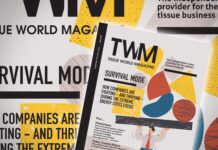Not only is China’s economic performance in 2020 a classic “V shaped” slump and recovery, when the multi-complexities of such a populous nation are reduced to a convenient shape on a performance chart, this “V” is steep and straight out of the economics manual.
In the turbulent year just gone, China was the only major economy to grow, at an aggregate 2.3%. That was a relative slump, the lowest figure for four decades, but the plain figure hardly begins to tell the story.
Severe virus containment measures saw a historic 6.8% contraction in Q1. By Q4, a unified national effort to contain the pandemic, and emergency business relief brought a near 14% upwards transformation to see growth at 6.5%. It’s expected to remain at that level this year.
The statistics on the general and tissue economies in China are in a league of their own. Historically, it has been the main driver of global tissue business expansion since 1997, and by a considerable margin. Volume growth has been well into the 30% category, the nearest regional rival being North America at an average of 14%.
China now leads the global volume tissue market space. Today, tissue products are part of normal daily life in an ever-increasing number of Chinese households.
Potential for growth is huge. From a relatively low tissue product usage base, a population estimated at 1.4bn has progressively more spending power and well-defined tastes for tissue products which are also now driven by increased concerns over hygiene. Traditional tissue-use regions on the eastern seaboard and the Beijing metropolitan area are now being widened into the hinterland of central and northern China. On the supply side there are few signs that investment activity is calming down. Investment figures have exploded in recent years, with major restructuring introducing new, modern PMs and older capacity closed for a combination of reasons.
2017 was the most recent peak year with more than 2 million tonnes of new tissue capacity starting up. The 1.9 million tonnes of new PMs each year for the period 2018-2020 includes the relatively slow year of 2018.
TWM’s Country Report on China takes in independent analysis from Leo Chen of Euromonitor International in Shanghai, and from Fisher International, among whose headline claims is that in the relatively near future Chinese tissue consumption could double even without any demographic change.
We also report from APP China with Zhang Ge, Chief Executive of the Gold Hongye Paper Group Co. She discusses the surge of new machinery sweeping away the old as revealed in TWM’s last edition’s annual Projects Survey, and makes clear that China’s recovery from the Covid-19 pandemic is more advanced than many other countries: The evidence … AfH is more or less “back to normal.”
An end-of-year report by the China National Household Paper Industry Association takes a detailed look at margins, soft and hardwood pulp and parent roll prices, investment, capacity, import and export and e-commerce business levels across China’s tissue companies.
We also look at the surge in popularity of WeChat, the Chinese multi-purpose messaging, social media and mobile payment app developed by Tencent, and used to engage with a company or brand about products. First released in 2011, it became the world’s largest standalone mobile app in 2018, with over 1 billion monthly active users. And we look at China coming to America. During the earlier stage of the pandemic Chinese-produced bamboo tissue products appeared for the first time on the shelves of American chain stores to meet unprecedented demand. Their presence didn’t last, as buying levels dropped and consumers reverted to earlier preference. But Chinese bamboo tissue already has a presence online, and more enterprises are offering impressive varieties to attract price-concerned savers, “green” loyalists and “white cloud” softness devotees. In ExitIssues, industry analyst Gregory Grishchenko looks at bamboo’s American future as production in China gears up.

































